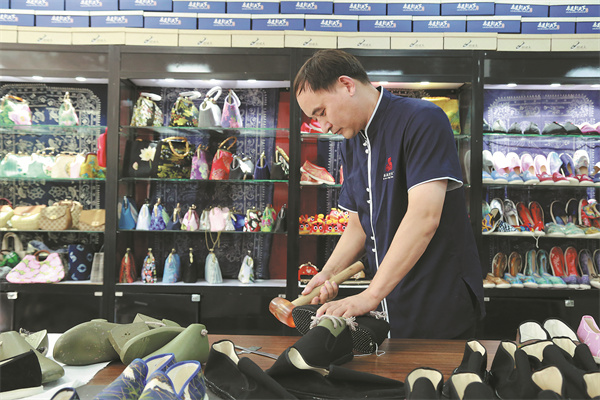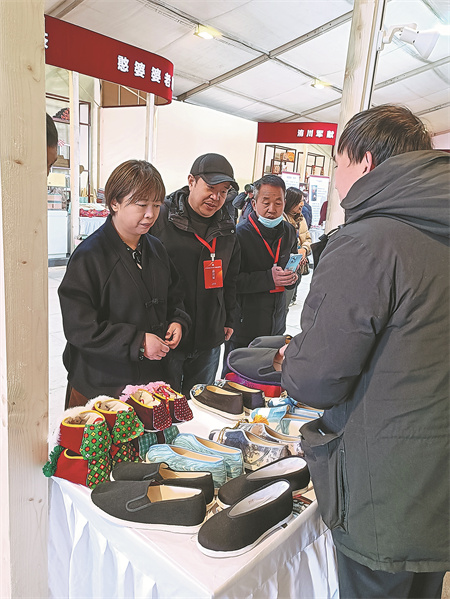Stepping into a New Career

Duan Yuguo molds cloth shoes with a hammer at his workshop in Gaozhuang village, Ruyang county, Henan province.[Photo provided to China Daily]
Cloth shoes with "thousand-layered soles", called qiancengdi buxie in Mandarin, have long been deemed by the Chinese, especially the older generation, as a sign of their mother's love. The shoe certainly is a work of devotion. Thousands of stitches have to be applied to fashion them out of layers of paper-thin cloth.
Although modern shoes made with high-tech materials have claimed center stage, traditional handmade cloth shoes have managed to survive the test of time and hang onto a niche market.
Duan Yuguo has tapped into the desire of those who seek comfort the old fashioned way and turned his family shoemaking heritage into a growing business that brings benefits beyond his family walls.
A group of women laid siege to Duan in early February, listening attentively as he demonstrated tips on how to make a special kind of shoe that has been passed down through his family for generations.
After Duan finished, he got them to practice. At his workshop in Gaozhuang village, Ruyang county, Luoyang, Central China's Henan province, he taught them to pound the soles, trim rough edges and shape the shoes.
During the process, Duan watched them closely, giving instructions to ensure their operations were on the right track.
"When sewing the shoe top, if the stitching is not straight, even by an inch, it can affect the appearance of the shoe and make it look less attractive," says Duan, who is in his 40s. "You just have to stick to the methods that work and practice them over and again, and things will turn out fine."
An array of simple but plush cloth shoes featuring diverse elements — including refined Suzhou-style embroidery, images of tiger heads and fashionable patterns — take up considerable space in Duan's workshop, making it look like a shoe museum.
"The shoes are crafted entirely from cotton and linen fabrics, using a composite made of flour and water as glue, without any chemical additives," Duan says. "This gives the shoes a breathable quality and makes them comfortable to wear."
 Visitors check cloth shoes at Duan's booth at an intangible cultural heritage exhibition held by Henan's provincial culture and tourism department and the Zhoukou city government.[Photo provided to China Daily]
Visitors check cloth shoes at Duan's booth at an intangible cultural heritage exhibition held by Henan's provincial culture and tourism department and the Zhoukou city government.[Photo provided to China Daily]
Imperial hue
Although Duan's shoes may not have a flashy appearance, they are indeed steeped in a rich history and carry strong cultural significance, Duan explains.
As early as the Emperor Qianlong's reign (1736-96) of the Qing Dynasty (1644-1911), predecessors of Duan's family made cloth shoes for court officials with their superb sewing and needlework skills.
In the 19th century, earlier generations of his family opened shoe stores in Ruyang and places as far away as Beijing, and drew in a large number of apprentices in Henan.
However, the booming cloth shoe family business hit a low ebb after social turmoil before the founding of the People's Republic of China in 1949 and failed to keep up with the times afterward.
"It broke off from the time of my father, who didn't carry on the family tradition," Duan says.
Fortunately, his mother Shi Xizhi managed to learn the craft from his grandfather, but she mainly made the shoes for domestic use.
"I watched her making the shoes in childhood and she let me play with the scraps of cloth," he recalls. "I felt curious when those pieces of cloth were turned into the shoes I wore."
These early memories were fresh in Duan's mind when his mother suggested reviving the family tradition in 2008. At the time, he was at a loss as to his future career, and "was doing odd jobs away from home and couldn't find a direction", he says.
After the conversation, Duan came back and started to learn his family's shoemaking skills from his mother.
Making a cloth shoe involves more than 100 steps, each of which makes or breaks the final outcome.
Described in broad strokes, one first needs to paint the shoe sole onto cloth before cutting it out with a pair of scissors. The step will be repeated many times to acquire multiple layers of the cloth in the shape of the sole.
Then paste is applied on the cloth strips to bind edges of the layers of cloth to form the foundation of the sole. Cotton will then be padded in and sewn onto the surface with a cloth cover.
"That is when the sole is finished," Duan says, adding that crafting the sole is the most important step.
After that, the sole is stitched together with the upper cloth.
Finishing touches include stuffing hot rubber in the shape of different foot parts in the shoe to fix the structure and fine-tune the design.
"All is done by hand and it takes about five to six days to finish a pair of cloth shoes," Duan says, noting that at least 2,100 stitches will be applied to a pair.
However, it wasn't plain sailing after he inherited the family shoe skills.
"There was still a long way to go before I could turn those shoes into commodity for the market. After all, they had been mostly made for our own family use," he says.